【2015年人教新目标】九年级英语unit8grammarfocus教案设计
- 格式:doc
- 大小:547.50 KB
- 文档页数:2
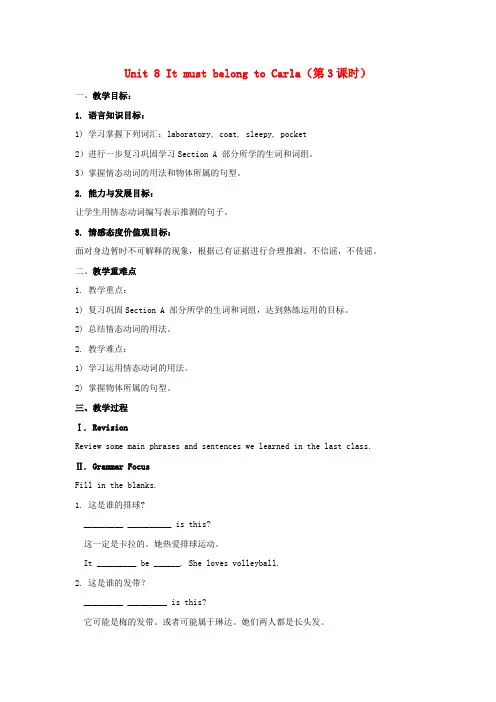
Unit 8 It must belong to Carla(第3课时)一、教学目标:1. 语言知识目标:1) 学习掌握下列词汇:laboratory, coat, sleepy, pocket2)进行一步复习巩固学习Section A 部分所学的生词和词组。
3)掌握情态动词的用法和物体所属的句型。
2. 能力与发展目标:让学生用情态动词编写表示推测的句子。
3. 情感态度价值观目标:面对身边暂时不可解释的现象,根据已有证据进行合理推测。
不信谣,不传谣。
二、教学重难点1. 教学重点:1) 复习巩固Section A 部分所学的生词和词组,达到熟练运用的目标。
2) 总结情态动词的用法。
2. 教学难点:1) 学习运用情态动词的用法。
2) 掌握物体所属的句型。
三、教学过程Ⅰ. RevisionReview some main phrases and sentences we learned in the last class. Ⅱ. Grammar FocusFill in the blanks.1. 这是谁的排球?_________ __________ is this?这一定是卡拉的。
她热爱排球运动。
It _________ be ______. She loves volleyball.2. 这是谁的发带?_________ _________ is this?它可能是梅的发带。
或者可能属于琳达。
她们两人都是长头发。
It _____ be Mei’s hair band. Or it ______ belong to Linda. They___ have long hair.3. 那晚你看见了什么?______ did you see that night?我不确定,但肯定不可能是狗。
它更大。
我想也许是一头熊或一匹狼。
I'm ____ _____, but it ____ _____a dog.It was bigger. I think it ____ _____ a bear or a wolf.Ⅲ. Try to Find情态动词表推测,可能性:must> can/could> may/might一、must表示可能性最大的肯定推测,意思是“一定、准是”。
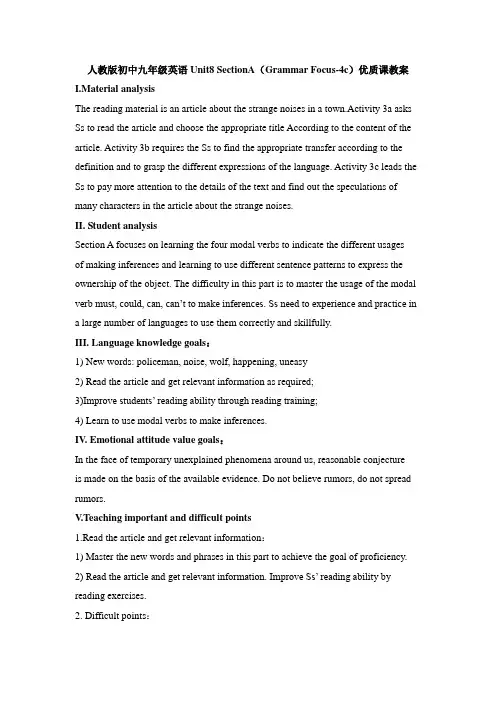
人教版初中九年级英语Unit8 SectionA(Grammar Focus-4c)优质课教案I.Material analysisThe reading material is an article about the strange noises in a town.Activity 3a asks Ss to read the article and choose the appropriate title According to the content of the article. Activity 3b requires the Ss to find the appropriate transfer according to the definition and to grasp the different expressions of the language. Activity 3c leads the Ss to pay more attention to the details of the text and find out the speculations of many characters in the article about the strange noises.II. Student analysisSection A focuses on learning the four modal verbs to indicate the different usagesof making inferences and learning to use different sentence patterns to express the ownership of the object. The difficulty in this part is to master the usage of the modal verb must, could, can, can’t to make inferences. Ss need to experience and practice in a large number of languages to use them correctly and skillfully.III. Language knowledge goals:1) New words: policeman, noise, wolf, happening, uneasy2) Read the article and get relevant information as required;3)Improve students’ reading ability through reading training;4) Learn to use modal verbs to make inferences.IV. Emotional attitude value goals:In the face of temporary unexplained phenomena around us, reasonable conjectureis made on the basis of the available evidence. Do not believe rumors, do not spread rumors.V.Teaching important and difficult points1.Read the article and get relevant information:1) Master the new words and phrases in this part to achieve the goal of proficiency.2) Read the article and get relevant information. Improve Ss’ reading ability by reading exercises.2. Difficult points:1) The ability of reading the article and getting relevant information.2) Understand and use the vocabulary and expressions.VI.Learning objectives1. Read to learn people’s opinions about the strange noises.2. To learn to use must, might, could and can’t to talk abo ut what people think about the strange noises.3. To learn the new words: drop, final, worried, owner.VII.Teaching stepsStep1 Warming up and revisionPlay a game. What’s in my handbag? Let Ss make inferences by using the sentence pattern There coul d/might/must/can’t be…in your handbag.Step2 Warming up and lead inPlay two games. Test your eyesight/listening.1. Present the new words in the article and learn them.2. How do you feel when you hear something strange at night?What might the strange thing be at midnight?Step3 ReadingWork on 3a:1. Tell Ss to read the article and decide which might be the best title.A. A Small and Quiet TownB.Strange Happenings in my townC.Animals in our neighborhoodSkimming: Look through the passage quickly to find the main idea without having to read every word.方法指导:先读懂所给的三个句子的意思,明确标题大意。
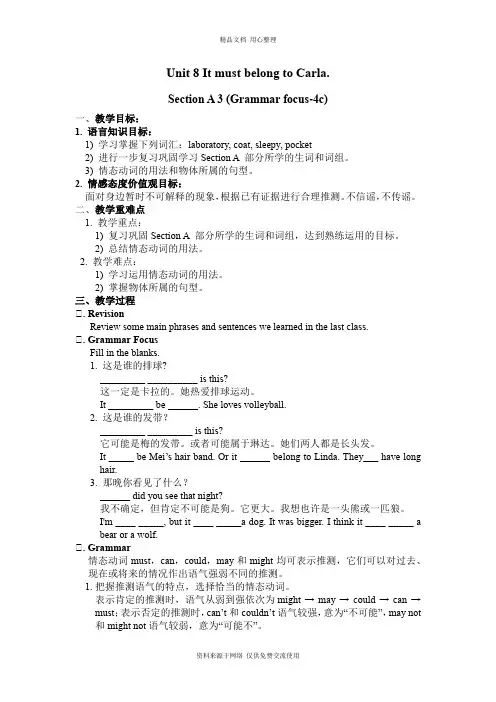
Unit 8 It must belong to Carla.Section A 3 (Grammar focus-4c)一、教学目标:1. 语言知识目标:1) 学习掌握下列词汇:laboratory, coat, sleepy, pocket2) 进行一步复习巩固学习Section A 部分所学的生词和词组。
3) 情态动词的用法和物体所属的句型。
2. 情感态度价值观目标:面对身边暂时不可解释的现象,根据已有证据进行合理推测。
不信谣,不传谣。
二、教学重难点1. 教学重点:1) 复习巩固Section A 部分所学的生词和词组,达到熟练运用的目标。
2) 总结情态动词的用法。
2. 教学难点:1) 学习运用情态动词的用法。
2) 掌握物体所属的句型。
三、教学过程Ⅰ. RevisionReview some main phrases and sentences we learned in the last class.Ⅱ. Grammar FocusFill in the blanks.1. 这是谁的排球?_________ __________ is this?这一定是卡拉的。
她热爱排球运动。
It _________ be ______. She loves volleyball.2. 这是谁的发带?_________ _________ is this?它可能是梅的发带。
或者可能属于琳达。
她们两人都是长头发。
It _____ be Mei’s hair band. Or it ______ belong to Linda. They___ have long hair.3. 那晚你看见了什么?______ did you see that night?我不确定,但肯定不可能是狗。
它更大。
我想也许是一头熊或一匹狼。
I'm ____ _____, but it ____ _____a dog. It was bigger. I think it ____ _____ a bear or a wolf.Ⅲ. Grammar情态动词must,can,could,may和might均可表示推测,它们可以对过去、现在或将来的情况作出语气强弱不同的推测。
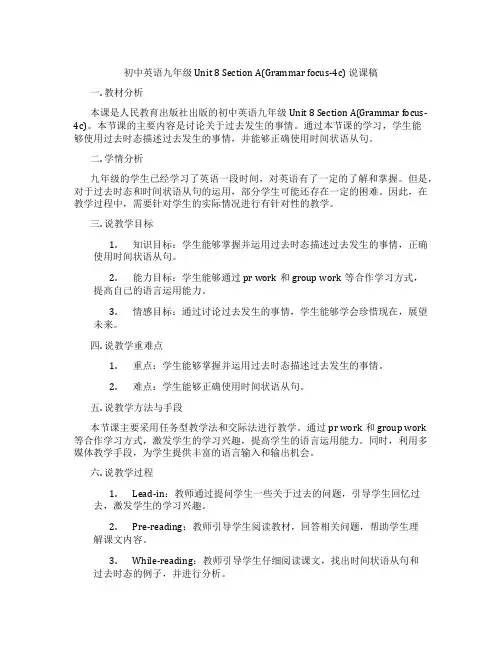
初中英语九年级 Unit 8 Section A(Grammar focus-4c) 说课稿一. 教材分析本课是人民教育出版社出版的初中英语九年级Unit 8 Section A(Grammar focus-4c)。
本节课的主要内容是讨论关于过去发生的事情。
通过本节课的学习,学生能够使用过去时态描述过去发生的事情,并能够正确使用时间状语从句。
二. 学情分析九年级的学生已经学习了英语一段时间,对英语有了一定的了解和掌握。
但是,对于过去时态和时间状语从句的运用,部分学生可能还存在一定的困难。
因此,在教学过程中,需要针对学生的实际情况进行有针对性的教学。
三. 说教学目标1.知识目标:学生能够掌握并运用过去时态描述过去发生的事情,正确使用时间状语从句。
2.能力目标:学生能够通过pr work和group work等合作学习方式,提高自己的语言运用能力。
3.情感目标:通过讨论过去发生的事情,学生能够学会珍惜现在,展望未来。
四. 说教学重难点1.重点:学生能够掌握并运用过去时态描述过去发生的事情。
2.难点:学生能够正确使用时间状语从句。
五. 说教学方法与手段本节课主要采用任务型教学法和交际法进行教学。
通过pr work和group work 等合作学习方式,激发学生的学习兴趣,提高学生的语言运用能力。
同时,利用多媒体教学手段,为学生提供丰富的语言输入和输出机会。
六. 说教学过程1.Lead-in:教师通过提问学生一些关于过去的问题,引导学生回忆过去,激发学生的学习兴趣。
2.Pre-reading:教师引导学生阅读教材,回答相关问题,帮助学生理解课文内容。
3.While-reading:教师引导学生仔细阅读课文,找出时间状语从句和过去时态的例子,并进行分析。
4.Post-reading:教师学生进行pr work和group work等活动,让学生运用所学知识进行实际操作。
5.Summary:教师引导学生总结本节课所学内容,帮助学生巩固记忆。
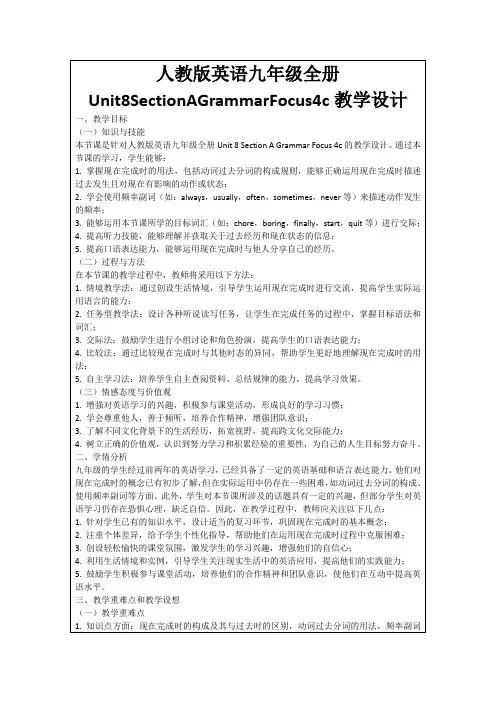
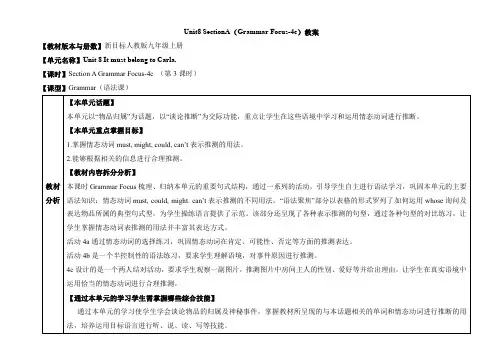
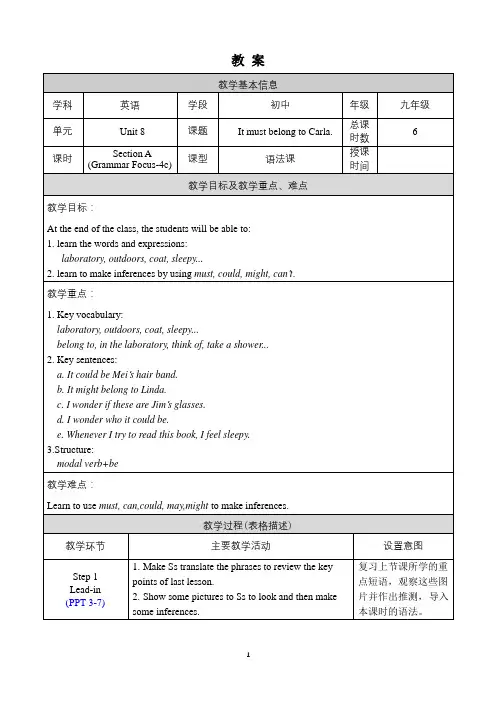
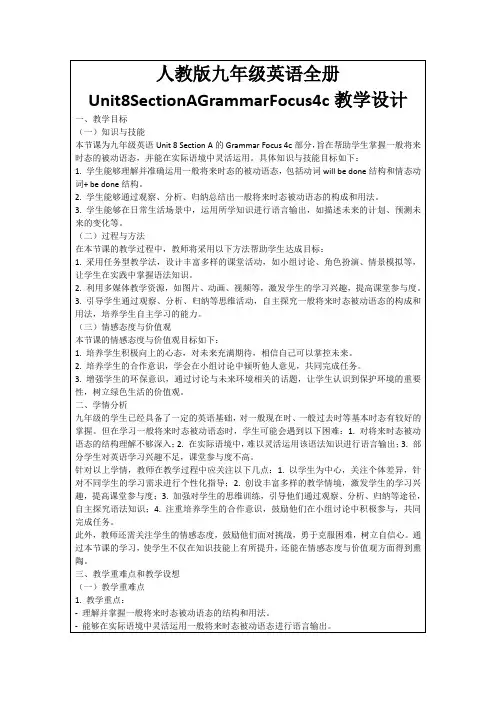
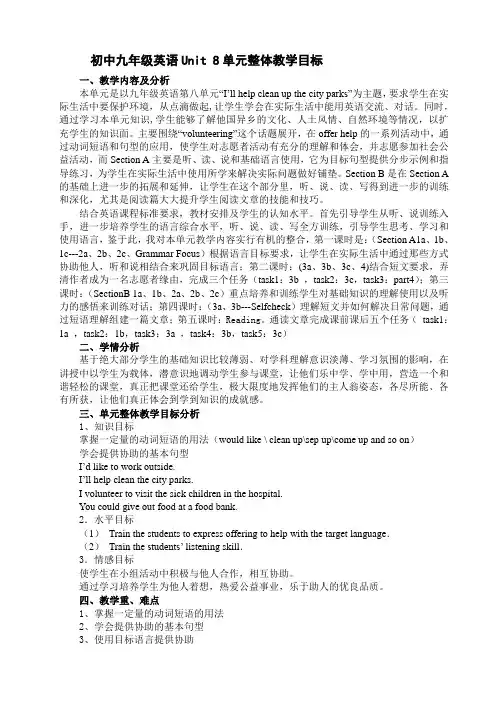
初中九年级英语Unit 8单元整体教学目标一、教学内容及分析本单元是以九年级英语第八单元“I’ll help clean up the city parks”为主题,要求学生在实际生活中要保护环境,从点滴做起,让学生学会在实际生活中能用英语交流、对话。
同时,通过学习本单元知识,学生能够了解他国异乡的文化、人土风情、自然环境等情况,以扩充学生的知识面。
主要围绕“volunteering”这个话题展开,在offer help的一系列活动中,通过动词短语和句型的应用,使学生对志愿者活动有充分的理解和体会,并志愿参加社会公益活动,而Section A主要是听、读、说和基础语言使用,它为目标句型提供分步示例和指导练习,为学生在实际生活中使用所学来解决实际问题做好铺垫。
Section B是在Section A 的基础上进一步的拓展和延伸,让学生在这个部分里,听、说、读、写得到进一步的训练和深化,尤其是阅读篇大大提升学生阅读文章的技能和技巧。
结合英语课程标准要求,教材安排及学生的认知水平。
首先引导学生从听、说训练入手,进一步培养学生的语言综合水平,听、说、读、写全方训练,引导学生思考、学习和使用语言,鉴于此,我对本单元教学内容实行有机的整合,第一课时是:(Section A1a、1b、1c---2a、2b、2c、Grammar Focus)根据语言目标要求,让学生在实际生活中通过那些方式协助他人,听和说相结合来巩固目标语言;第二课时:(3a、3b、3c、4)结合短文要求,弄清作者成为一名志愿者缘由,完成三个任务(task1:3b ,task2:3c,task3:part4);第三课时:(SectionB 1a、1b、2a、2b、2c)重点培养和训练学生对基础知识的理解使用以及听力的感悟来训练对话;第四课时:(3a、3b---Selfcheck)理解短文并如何解决日常问题,通过短语理解组建一篇文章;第五课时:Reading。


初中英语九年级 Unit 8 Section A(Grammar focus-4c) 教学设计一. 教材分析本课选自人教版英语九年级Unit 8 Section A (Grammar focus-4c),主要讨论了关于过去发生的事情的句子结构。
本节课主要让学生掌握一般过去时的构成和用法,能够正确运用一般过去时描述过去发生的事情。
通过本节课的学习,学生能够提高自己的语言运用能力,更好地理解和描述过去的事件。
二. 学情分析九年级的学生已经掌握了英语学习的基本语法知识和词汇量,具备一定的听说读写能力。
但是,对于一般过去时的构成和用法还不够熟练,需要通过本节课的学习来进一步巩固和提高。
同时,学生对于描述过去事件的句子结构还不够熟悉,需要通过实例分析和实践来提高。
三. 教学目标1.知识目标:学生能够掌握一般过去时的构成和用法,能够正确运用一般过去时描述过去发生的事情。
2.能力目标:学生能够提高自己的语言运用能力,更好地理解和描述过去的事件。
3.情感目标:通过本节课的学习,学生能够增强学习英语的兴趣和自信心。
四. 教学重难点1.重点:学生能够掌握一般过去时的构成和用法。
2.难点:学生能够正确运用一般过去时描述过去发生的事情。
五. 教学方法本节课采用任务型教学法,通过任务驱动的方式引导学生参与课堂活动,提高学生的学习兴趣和积极性。
同时,采用合作学习法,让学生在小组内进行讨论和实践,提高学生的团队合作能力和语言运用能力。
六. 教学准备1.教师准备:教师需要提前准备相关教学材料,如PPT、练习题等。
2.学生准备:学生需要提前预习相关内容,了解一般过去时的基本知识。
七. 教学过程1.导入(5分钟)教师通过提问方式引导学生回顾已学过的时态,为新课的学习做好铺垫。
例如:“我们已经学过哪些时态?它们分别用来描述什么情况?”2.呈现(10分钟)教师通过PPT展示一般过去时的句子结构,并解释其用法。
同时,通过举例让学生理解一般过去时的含义。
Unit 8 Grammar FocusClass Type GrammarObjectives 1.To understand the modal verbs “must, might, could, can’t” for making inferences.2.To practice using the modal verbs to make sentences.Key structure 1. Whose volleyball is this?—It must be Carla’s. S he loves volleyball.2. Whose hair band is this?—It could be Mei’s. Or it might belong to Linda. They both have long hair.3.What did you see that night?—I’m not sure, but it can’t be a dog.Difficulties How to practice well using these modal verbs “must, might, could, can’t” for making inferences.Period 1ProcedureLead-in Revision.Translate the English phrases into Chinese.Step 1 Read the sentences with the modal verbs underlined.Step 2 The information about the modal verbs referring to the inference.Step 3 The differences and uses of “can, could”.Step 4 The differences and uses of “might, may”.Step 5 The differences and uses of “must, have to”.Step 6 The different situations about inferring sentences with modal verbs.Step 7 Exercises.Complete the sentences with the right words.Step 8 Activity 4a.Choose the best way to complete each sentence using thewords in brackets.Step 9 Activity 4b.Ask Ss to complete these responses.Step 10 Free talk.Look at two rooms below. Ask Ss to make guesses aboutthe owner of each room.Step 11 More exercises about choosing the best answers.。
Unit 8It must belong to Carla.Section A (1a-2d)1.重点单词:whose,truck,rabbit,attend,valuable,pink,picnic,anybody2.重点短语:belong to,at the picnic,pick up3.重点句式:—Whose volleyball is this?—It must be Carla's.She loves volleyball.The hair band might belong to Linda.It can't be stolen.It could be Mei's hair band.1.重点短语和句型2.must,might,could和can't 表示推测的用法must,might,could和can't 表示推测的用法一、预习课本P57-58新单词并背诵,完成下面的汉译英。
1.谁的________ 2.卡车________3.野兔________ 4.出席________5.贵重的________ 6.粉红色________7.野餐________ 8.任何人________二、认真预习1a-2d找出下列短语和句型。
1.属于________________________________________________________________________ 2.参加野餐________________________________________________________________________ 3.捡起________________________________________________________________________ 4.—这是谁的排球?—它一定是卡拉的。
她喜欢排球。
________________________________________________________________________ ________________________________________________________________________ 5.这个发带可能是琳达的。
Unit 8 It must belong to Carla.Section A Grammar focus4c教学步骤课堂活动学生活动设计意图Step 1 Review 1.Greeting.2.Enjoy a video and lead Ss tofind out modal verbs forspeculation.看视频,找出情态动词表推测的句子。
通过视频,导入目标语块。
语言简单易懂,贴合生活实际。
便于快速调动学生学习热情,进入课堂模式。
效果评价学生是否表现出兴趣和专注,是否感知情态动词表推测的用法,观察学生的掌握情况,便于课程进度把握。
Step 2 Grammar Focus 1.Grammar Focus.Ask Ss to readthe sentences loudly.2.Have Ss observe and find outmodal verbs for speculation.3.Get Ss Read the sentences inGrammar Focus again, work ingroups and Summarize thegrammar rules.4.Lead Ss to learn the rules indifferent situation朗读GrammarFocus并找出表推测的情态动词用法。
发现、归纳情态动词must,could, might,can’t表推测的用法。
通过观察法,充分发挥学生的主观能动性,语法规则由学生自寻,老师扮演引导者和辅助者的角色,有利于学生创造性思维的培养。
教学过程中注意引用典例的趣味性,保持课堂气氛的活跃度。
学习不同时态下,情态动词表推测的用法。
效果评价学习新知时,是否专注且积极,能否根据语气和时态,准确运用情态动词。
Step 3 Presentation 1.Ask Ss to read the sentences in4a.Then choose the best way toplete each sentence using thewords in the brackets.2.Work on 4b.plete theseresponses.3.Work on 4c.Look at this pictureof a room. How much can youtell about the person who liveshere? Is it a boy or a girl?Whatare his/her hobbies? Discussyour ideas with a partner.完成4a。
Unit 8 Grammar Focus
Class Type Grammar
Objectives 1. To understand the modal verbs “m ust, might, could,
can’t”f or making inferences.
2. To practice using the modal verbs to make sentences.
Key 1. Whose volleyball is this?
structure —It must be Carla’s. She loves volleyball.
2. Whose hair band is this?
—It could be Mei’s. Or it might belong to Linda. They
both have long hair.
3. What did you see that night?
—I ’m not sure, but it can’t be a dog.
Difficulties How to practice well using these modal verbs“m ust, might,
could, can’t”f or making inferences.
Period 1
Procedure
Lead-in Revision.
Translate the English phrases into Chinese.
Step 1 Read the sentences with the modal verbs underlined.
Step 2 The information about the modal verbs referring to the
inference.
Step 3 The differences and uses o“f can, could”.
Step 4 The differences and uses o“f might, may”.
Step 5 The differences and uses o“f must, have to”.
Step 6 The different situations about inferring sentences with
modal verbs.
Step 7 Exercises.
Complete the sentences with the right words.
Step 8 Activity 4a.
Choose the best way to complete each sentenceusing the
words in brackets.
Step 9 Activity 4b.
Ask Ss to complete these responses.
Step 10 Free talk.
Look at two rooms below. Ask Ss to make guessesabout
the owner of each room.
Step 11 More exercises about choosing the best answers.。